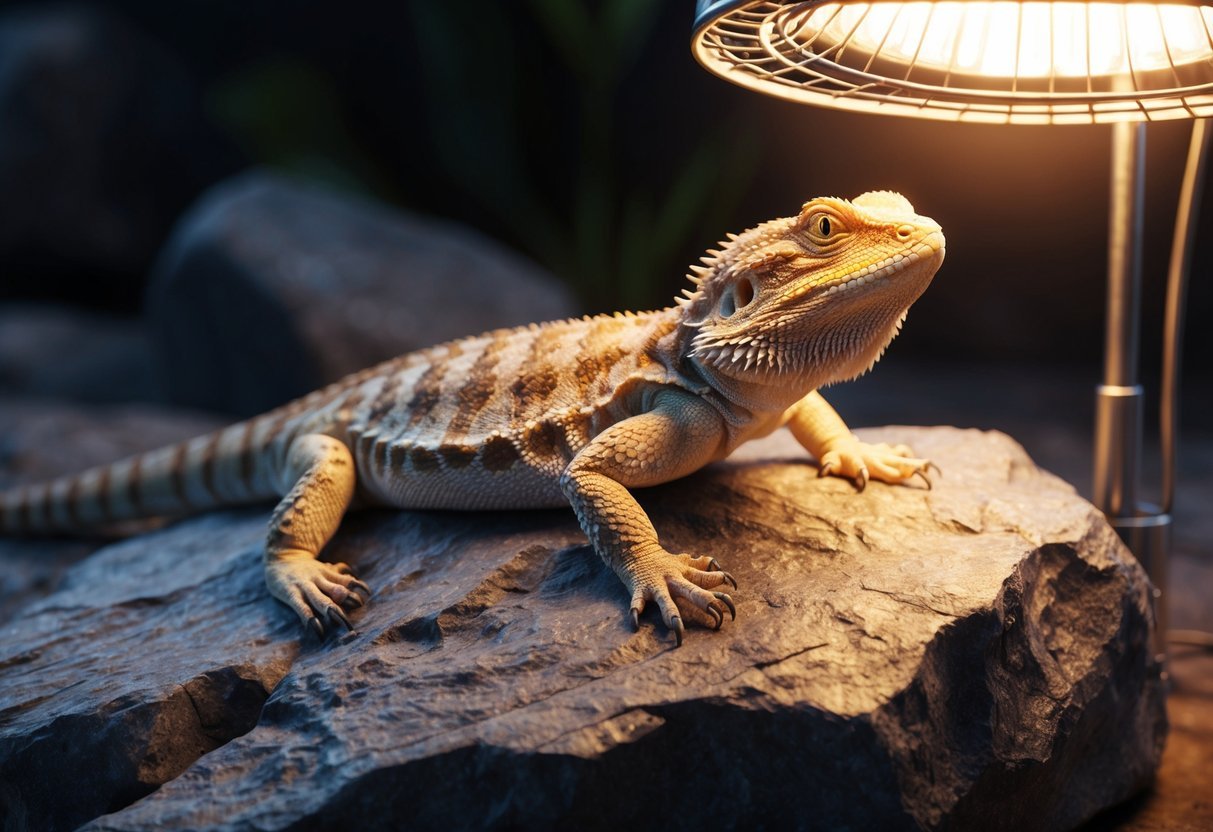Bearded dragons are fascinating lizards that make great pets. These friendly reptiles are native to Australia and belong to the genus Pogona. They get their name from the spiky scales under their chins that look like a beard.
Bearded dragons are easy to care for, docile, and enjoy being handled, making them perfect for both new and experienced reptile owners. They have unique personalities and can even recognize their owners. These lizards come in different colors and patterns, adding to their appeal as pets.
Bearded dragons need a special setup to thrive. They require a large tank, proper lighting, and a varied diet. With the right care, these lovable lizards can live up to 15 years, giving you plenty of time to bond with your scaly friend.
Let’s explore what makes bearded dragons such popular pets and how to keep them happy and healthy.
Bearded Dragon Origins
Bearded dragons come from Australia and have become popular pets around the world. These lizards have an interesting history and natural habitat.
Native Habitats
Bearded dragons live in many parts of Australia. They like dry areas like deserts and woodlands. The central bearded dragon (Pogona vitticeps) is the most common pet species. These lizards can be found in central Australia.
In the wild, bearded dragons climb trees and bask in the sun. They eat plants and small animals. Bearded dragons have spiky scales that help them stay safe from predators.
History and Export
People started keeping bearded dragons as pets in the 1960s. Bearded dragons gained popularity as pets during the 1990s. Many were bred in captivity for the pet trade.
Australia stopped allowing wild bearded dragon exports. But breeders in other countries kept raising them. Now, most pet bearded dragons are born in captivity.
In the United States, bearded dragons became very popular. They’re friendly and easy to care for. This makes them great pets for both new and experienced reptile owners.
Physical Characteristics
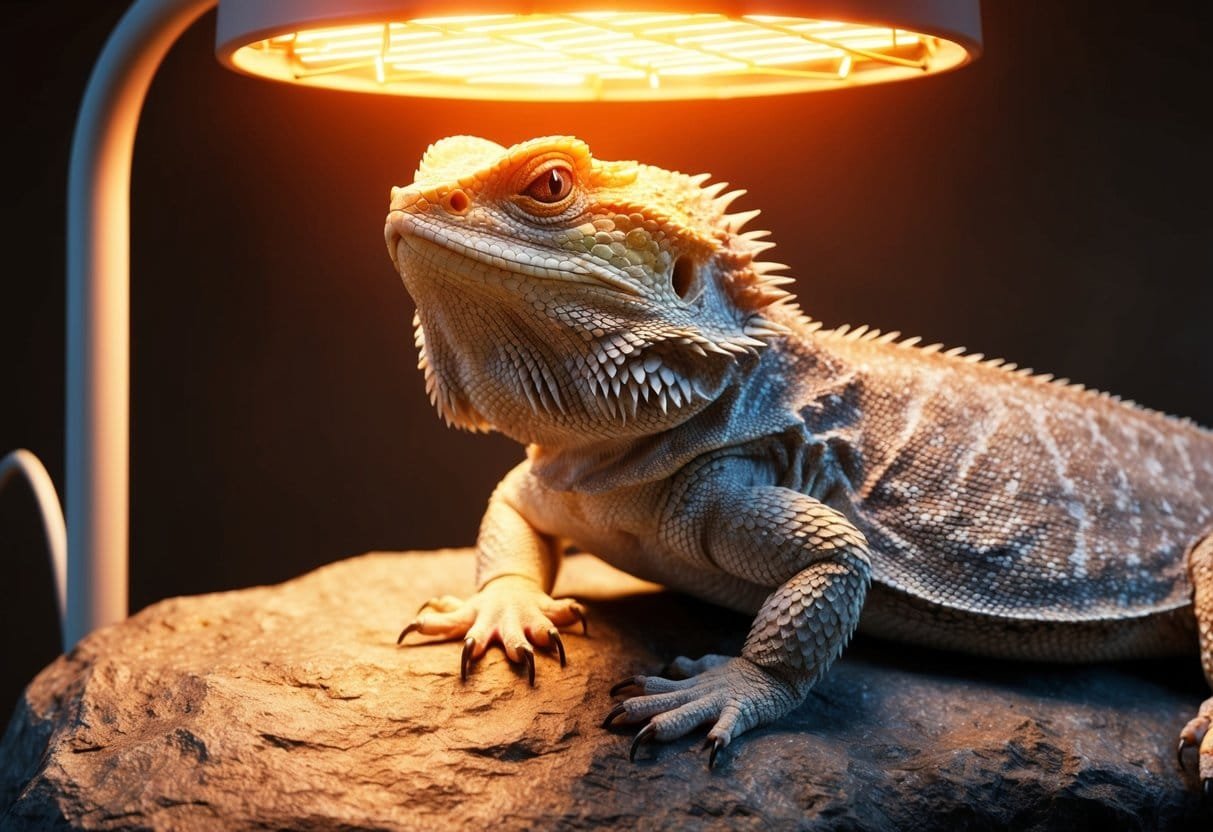
Bearded dragons have unique features that make them stand out. Their scaly bodies and spiky beards give them a distinctive look.
Size and Scales
Bearded dragons are medium-sized lizards. They usually grow to be 12-24 inches long from head to tail. Their bodies are covered in rough scales that help protect them.
These scales feel bumpy to the touch. On their sides and backs, beardies have rows of spiky scales. These spikes make them look tough and cool.
The most famous feature is their “beard.” This is made up of spiky scales under their chin. When they feel scared or angry, they puff out this beard to look bigger.
Color and Morph Varieties
Bearded dragons come in many colors. In the wild, they’re often brown or tan to blend in with their surroundings. But pet beardies can be much more colorful!
Breeders have made new color types called “morphs.” These can be red, yellow, orange, and even purple or white. Some have patterns like stripes or spots.
Central Bearded Dragons can change color to match their environment. This helps them stay safe from predators. Males tend to be brighter in color than females.
The variety of colors makes bearded dragons fun pets. Each one can look unique and special.
Bearded Dragon Behavior
Bearded dragons have unique behaviors that help them communicate and regulate their body temperature. These reptiles use body language and physical actions to interact with others and adjust to their environment.
Social Interaction
Bearded dragons use head bobbing and arm waving to communicate with each other. Head bobbing can show dominance or aggression. Fast bobbing often means the dragon feels territorial.
Slow head bobbing may indicate submission. Arm waving is usually a sign of recognition or submission. It’s like saying “I see you” to another dragon.
When feeling threatened, bearded dragons may hiss. This warns others to back off. They might also puff out their beards and open their mouths wide to look bigger and scarier.
A dragon’s mood can change based on its environment. Stress from things like loud noises or frequent handling may cause unusual behaviors.
Basking and Activity Patterns
Bearded dragons are diurnal, meaning they’re active during the day. They need to bask under a heat source to warm up their bodies. This helps them digest food and stay healthy.
In the morning, dragons often bask to get ready for the day. They may stretch out flat to soak up heat. As they warm up, they become more active and alert.
During the hottest part of the day, bearded dragons might seek shade or cooler spots. They may become less active to conserve energy. In the evening, they often bask again before settling down for the night.
Glass surfing is when a dragon runs back and forth along the glass of its enclosure. This can be a sign of stress or boredom. It might mean the dragon needs more space or stimulation.
Habitat Setup
Setting up the right home for your bearded dragon is key to keeping them happy and healthy. A good habitat has the right size, temperature, and things for your dragon to explore.
Enclosure Requirements
Bearded dragons need a big home to move around in. Adult bearded dragons need a tank that’s at least 125 gallons. This gives them space to walk, bask, and hide.
The tank needs different heat zones. One end should be warm for basking, around 95-110°F. The other end should be cooler, about 75-85°F. You can use a basking lamp to create this heat gradient.
Lighting is super important too. Bearded dragons need UVB and UVA light. This helps them make vitamin D3 and stay healthy. Use special reptile lights and turn them on for 12 hours each day.
Substrate and Furnishings
The floor of the tank, or substrate, should be safe and easy to clean. Many people use reptile carpet, tile, or newspaper. Avoid loose substrates like sand, as dragons might eat it by accident.
Add some fun stuff for your dragon to climb on and hide in. Rocks and branches are great for climbing and basking. Make sure they’re secure and won’t fall.
Hides are important too. Your dragon needs a cool, dark spot to rest. You can use store-bought hides or make your own from safe materials.
Keep the tank at the right humidity, about 30-40%. Use a spray bottle to mist the tank if it gets too dry. A water dish can also help with humidity and give your dragon a place to soak.
Dietary Needs
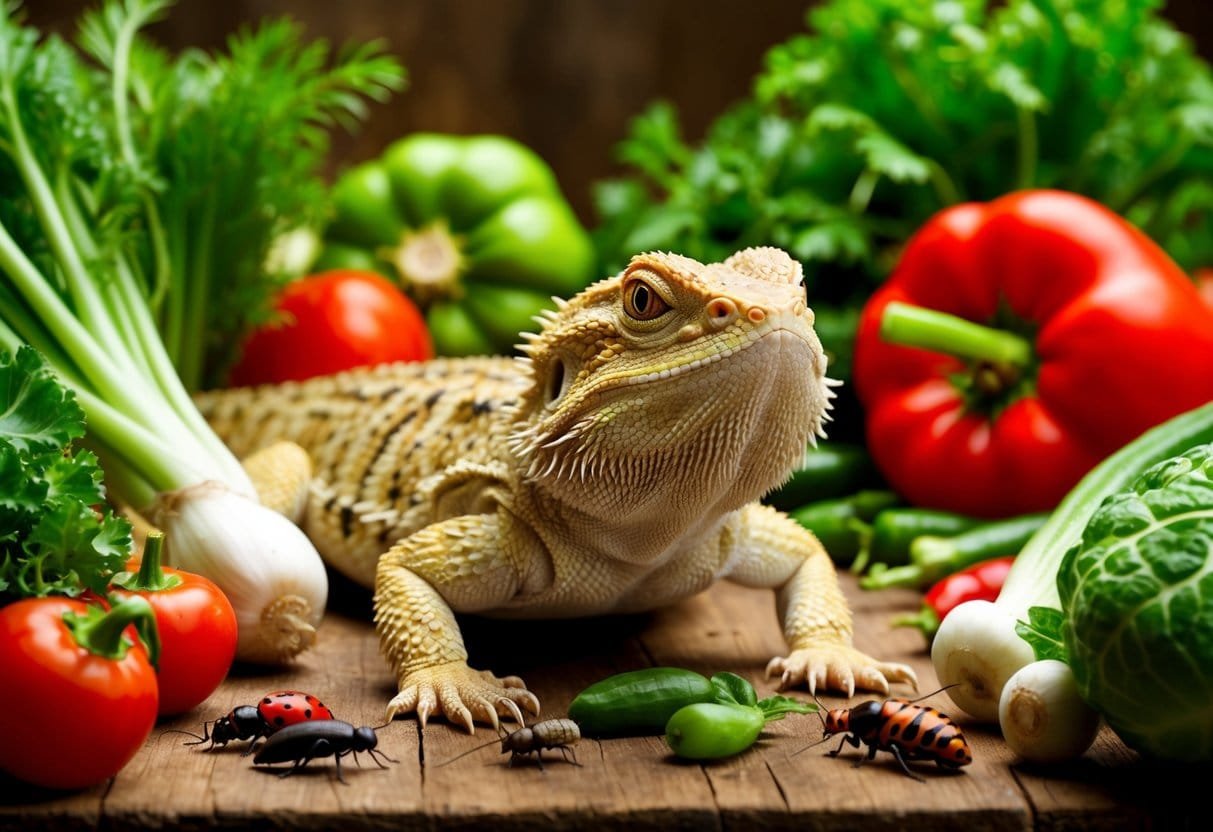
Bearded dragons need a mix of insects and plants to stay healthy. They eat different amounts of each as they grow. Proper nutrition and supplements are key for these pet lizards.
Feeding Your Bearded Dragon
Bearded dragons are omnivores. They eat both insects and plants. Young beardies need more insects, while adults need more plants.
Baby beardies should eat:
- 80% insects
- 20% plants
They can eat up to 60 bugs a day! Feed them 3 times daily for 10-15 minutes each time.
Adult beardies should eat:
- 20-30% insects
- 70-80% plants
Good insect choices are crickets and roaches. Offer leafy greens like collards and mustard greens daily. Give fruit as a treat.
Always check that insects aren’t too big. If a bug is longer than the space between your dragon’s eyes, it’s too large.
Supplements and Water
Bearded dragons need extra calcium and vitamins. Dust their food with calcium powder 3-4 times a week. Use a multivitamin once a week.
Keep fresh, clean water available at all times. Change it daily. Some dragons don’t drink much, so mist their veggies to help them stay hydrated.
Proper supplements help prevent health issues. They’re very important for growing dragons and egg-laying females.
Gut-load insects before feeding them to your dragon. This means feeding the bugs nutritious foods. It makes the insects more healthy for your pet.
Health Care
Keeping your bearded dragon healthy involves regular check-ups and watching for signs of illness. Good care prevents many common issues, but knowing what to look out for helps catch problems early.
Common Health Issues
Bearded dragons can face several health challenges. Metabolic bone disease is a serious condition caused by calcium deficiency. Signs include weak bones, tremors, and difficulty moving.
Shedding problems may occur if humidity is too low. Stuck shed can lead to circulation issues if not addressed.
Impaction happens when dragons eat something they can’t digest. This can cause constipation or blockages.
Respiratory infections are another concern. Watch for wheezing, bubbles around the mouth, or loss of appetite.
Preventative Care
Regular vet check-ups are key to keeping your dragon healthy. Aim for annual visits to catch issues early.
Proper diet and supplements help prevent many health problems. Offer a variety of insects and vegetables. Dust food with calcium powder.
UVB lighting is crucial for vitamin D3 production and calcium absorption. Replace bulbs every 6-12 months.
Keep the enclosure clean to prevent infections. Spot clean daily and do a deep clean monthly.
Monitor your dragon’s behavior and appetite. Quick action on changes can prevent serious illness.
Reproduction and Breeding
Bearded dragons have interesting mating habits and egg-laying processes. Proper care during breeding and for hatchlings is key to success.
Mating and Incubation
Bearded dragons mate when they reach about 18 months old. Males should weigh at least 360 grams and be 7-8 inches long. Females are often larger than males.
Breeding season typically starts after brumation in early spring. The male will bob his head and wave his arm to attract a female. If she’s interested, she’ll bob her head too.
After mating, the female lays 15-30 eggs in a clutch. She may lay multiple clutches per season. Eggs take 50-80 days to hatch, with 60 days being average.
Incubation temperature affects hatching time and behavior.
Warmer temps around 86°F lead to faster hatching in about 60 days. Cooler temps of 80°F result in 90-day incubation periods.
Caring for Hatchlings
Baby bearded dragons need special care when they hatch. They should be housed separately from adults in a smaller enclosure.
Provide shallow water dishes and mist the enclosure daily for hydration. Feed hatchlings small insects like pinhead crickets or fruit flies 2-3 times per day.
Calcium supplements are crucial for proper bone development. Dust food items with calcium powder at every feeding.
Maintain proper lighting with UVB bulbs to help babies absorb calcium. Keep temperatures around 95°F on the basking side and 85°F on the cool side.
Handle babies gently and briefly at first. As they grow, gradually increase handling time to socialize them.
Handling and Interaction
Bearded dragons can be great pets when handled properly. Gentle interaction helps build trust and lets you bond with your scaly friend.
Bonding With Your Pet
Handling your bearded dragon often is key to bonding. Start with short 5-minute sessions and slowly increase the time. Be very gentle when picking up your dragon. Support its whole body and lift from underneath, not by grabbing around the middle.
Talk softly to your dragon as you handle it. This helps it get used to your voice. Offer treats during handling time to create positive associations.
Many bearded dragons enjoy being petted gently on the head or back. Some even like to cuddle on your chest or shoulder. Pay attention to what your dragon likes.
Reading Your Dragon’s Body Language
Bearded dragons use body language to show how they feel. A happy, relaxed dragon will have a flat beard and body. Its eyes may be partly closed.
Watch for signs of stress like a puffed-out beard, gaping mouth, or quick head bobbing. These can mean your dragon feels scared or threatened.
A dragon that turns black or opens its mouth wide may be trying to look bigger. This could be a sign of fear or aggression.
Gentle arm waving is usually a friendly gesture. Fast tail whipping, on the other hand, often means the dragon is upset.
Learning to read these signals helps you understand your pet’s mood. This makes handling easier and more enjoyable for both of you.
Choosing a Bearded Dragon
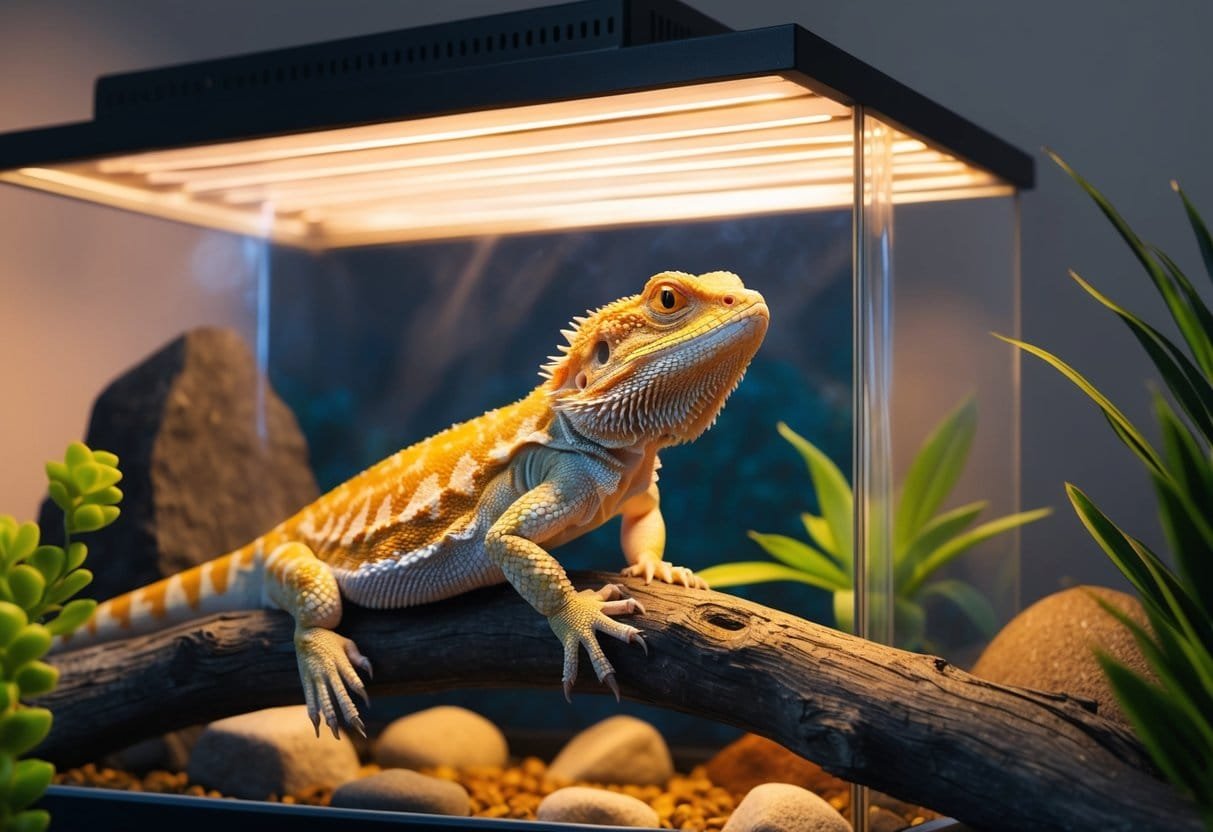
Picking the right bearded dragon takes care and thought. It’s important to look for a healthy pet from a good source. This helps make sure your new friend will be happy in its new home.
Selecting the Right Pet
When choosing a bearded dragon, look for one that seems alert and active. Its body should be round without any bones sticking out. Check that all toes and the tail are there. A healthy dragon will have bright, clear eyes and clean nostrils.
Young dragons are fun, but they need more care. Adult dragons might be easier for new owners. Either way, the dragon should react when someone gets close to its cage.
Watch how the dragon moves. It should walk smoothly without wobbling. Gentle handling is key to see how the dragon acts with people.
Reputable Sources
It’s best to get a bearded dragon from captive-bred sources. These dragons often adjust better to living with humans. Reputable breeders are a good choice. They can answer questions and give advice on care.
Some pet stores also sell healthy bearded dragons. But it’s important to check the store’s reputation first. Look for clean cages and staff who know about dragon care.
Wherever you get your dragon, ask about its history. Find out what it eats and how old it is. This info helps meet the dragon’s needs in its new home.
Conservation Status
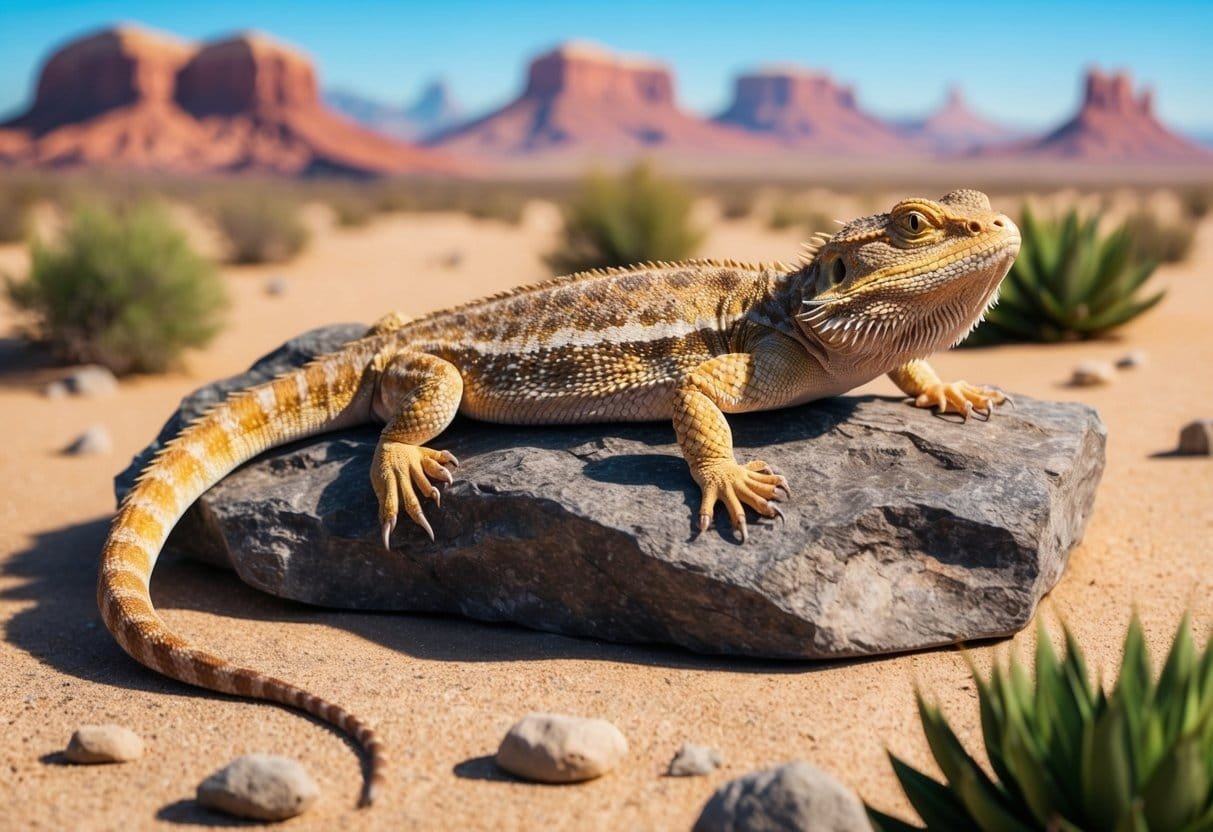
Bearded dragons face some challenges in the wild, but efforts are being made to protect them. Their status varies depending on the specific species and location.
Wild Populations
The Eastern Bearded Dragon is not at risk of extinction. It’s listed as “Least Concern” on conservation lists. This means they’re doing okay in the wild for now.
But they still face threats. People are building more houses and farms in Australia. This takes away the dragons’ homes.
Bigger animals like birds and snakes eat bearded dragons too. This is normal, but it can be hard for dragon babies to survive.
Climate change might also cause problems. It could make their homes too hot or dry.
Conservation Efforts
People are working to help bearded dragons. They’re trying to save the places where dragons live in Australia.
Some groups watch dragon numbers to make sure they’re not going down. If they see problems, they can act quickly.
Zoos and pet owners help too. They learn how to take care of dragons. This knowledge can help wild dragons if needed.
There are rules about catching wild dragons. This stops too many from being taken from nature.
People are also studying how dragons live. This info helps make better plans to protect them.

